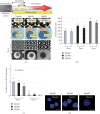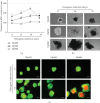Size-Optimized Microspace Culture Facilitates Differentiation of Mouse Induced Pluripotent Stem Cells into Osteoid-Rich Bone Constructs
- PMID: 32508932
- PMCID: PMC7244985
- DOI: 10.1155/2020/7082679
Size-Optimized Microspace Culture Facilitates Differentiation of Mouse Induced Pluripotent Stem Cells into Osteoid-Rich Bone Constructs
Abstract
Microspace culture is promising for self-organization of induced pluripotent stem cells (iPSCs). However, the optimal size of microspaces for osteogenic differentiation is unclear. We hypothesized that a specific microspace size could facilitate self-organizing iPSC differentiation to form bone-like tissue in vitro. The objectives of this study were to investigate such effects of microspace size and to evaluate bone regeneration upon transplantation of the resulting osteogenic constructs. Dissociated mouse gingival fibroblast-derived iPSCs were plated in ultra-low-attachment microspace culture wells containing hundreds of U-bottom-shaped microwell spots per well to form cell aggregates in growth medium. The microwells had different aperture diameters/depths (400/560 μm (Elp400), 500/700 μm (Elp500), and 900/700 μm (Elp900)) (Kuraray; Elplasia). After 5 days of aggregation, cells were maintained in osteogenic induction medium for 35 days. Only cells in the Elp500 condition tightly aggregated and maintained high viability during osteogenic induction. After 10 days of induction, Elp500 cell constructs showed significantly higher gene expression of Runx2, Osterix, Collagen 1a1, Osteocalcin, Bone sialoprotein, and Osteopontin compared to constructs in Elp400 and Elp900. In methylene blue-counterstained von Kossa staining and Movat's pentachrome staining, only Elp500 constructs showed robust osteoid formation on day 35, with high expression of type I collagen (a major osteoid component) and osteocalcin proteins. Cell constructs were transplanted into rat calvarial bone defects, and micro-CT analysis after 3 weeks showed better bone repair with significantly higher bone mineral density in the Elp500 group compared to the Elp900 group. These results suggest that microspace size affects self-organized osteogenic differentiation of iPSCs. Elp500 microspace culture specifically induces mouse iPSCs into osteoid-rich bone-like tissue possessing high bone regeneration capacity.
Copyright © 2020 Phoonsuk Limraksasin et al.
Conflict of interest statement
The authors declare that they have no conflicts of interest.
Figures







Similar articles
-
In Vitro Fabrication of Hybrid Bone/Cartilage Complex Using Mouse Induced Pluripotent Stem Cells.Int J Mol Sci. 2020 Jan 16;21(2):581. doi: 10.3390/ijms21020581. Int J Mol Sci. 2020. PMID: 31963264 Free PMC article.
-
Insulin-like growth factor 2 promotes osteogenic cell differentiation in the parthenogenetic murine embryonic stem cells.Tissue Eng Part A. 2012 Feb;18(3-4):331-41. doi: 10.1089/ten.TEA.2011.0074. Epub 2011 Oct 18. Tissue Eng Part A. 2012. PMID: 21902466
-
Conditioned Medium Enhances Osteogenic Differentiation of Induced Pluripotent Stem Cell-Derived Mesenchymal Stem Cells.Tissue Eng Regen Med. 2019 Jan 29;16(2):141-150. doi: 10.1007/s13770-018-0173-3. eCollection 2019 Apr. Tissue Eng Regen Med. 2019. PMID: 30989041 Free PMC article.
-
Scaffold-Free Fabrication of Osteoinductive Cellular Constructs Using Mouse Gingiva-Derived Induced Pluripotent Stem Cells.Stem Cells Int. 2016;2016:6240794. doi: 10.1155/2016/6240794. Epub 2016 Mar 27. Stem Cells Int. 2016. PMID: 27110251 Free PMC article.
-
A Method for In Vitro Fabrication of Hybrid Bone/Cartilage Tissue Using Mouse Induced Pluripotent Stem Cells.Methods Mol Biol. 2022;2454:509-520. doi: 10.1007/7651_2021_361. Methods Mol Biol. 2022. PMID: 33755902
Cited by
-
Shear Stress Regulates Osteogenic Differentiation of Human Dental Pulp Stem Cells via the p38 Pathway.Int J Mol Sci. 2025 Jun 13;26(12):5667. doi: 10.3390/ijms26125667. Int J Mol Sci. 2025. PMID: 40565131 Free PMC article.
-
Application of shear stress for enhanced osteogenic differentiation of mouse induced pluripotent stem cells.Sci Rep. 2022 Nov 8;12(1):19021. doi: 10.1038/s41598-022-21479-8. Sci Rep. 2022. PMID: 36347883 Free PMC article.
-
A combined 3D printing/CNC micro-milling method to fabricate a large-scale microfluidic device with the small size 3D architectures: an application for tumor spheroid production.Sci Rep. 2020 Dec 17;10(1):22171. doi: 10.1038/s41598-020-79015-5. Sci Rep. 2020. PMID: 33335148 Free PMC article.
-
Intermittent compressive force induces cell cycling and reduces apoptosis in embryoid bodies of mouse induced pluripotent stem cells.Int J Oral Sci. 2022 Jan 4;14(1):1. doi: 10.1038/s41368-021-00151-3. Int J Oral Sci. 2022. PMID: 34980892 Free PMC article.
-
Stem Cells and Their Derivatives-Implications for Alveolar Bone Regeneration: A Comprehensive Review.Int J Mol Sci. 2021 Oct 29;22(21):11746. doi: 10.3390/ijms222111746. Int J Mol Sci. 2021. PMID: 34769175 Free PMC article. Review.
References
-
- O'Brien F. J. Biomaterials & scaffolds for tissue engineering. Materials Today. 2011;14(3):88–95. doi: 10.1016/S1369-7021(11)70058-X. - DOI
LinkOut - more resources
Full Text Sources
Research Materials

